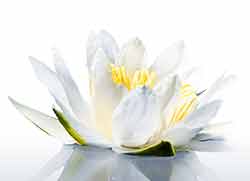
Dr Edward Bach - the Life & Work of Dr Bach
Creator of the Bach Flower Remedies
Born in 1886, Edward Bach lead a fascinating life, driven throughout by his deep desire to find the truth about human illness & disease and to provide a cure in the form of a simple medicine available for all. His journey of discovery took him from medical doctor, eminent bacteriologist and a successful Harley Street practice to a deeper exploration of the human condition. His research lead him to connect deeply with the healing potential of nature and expand his own connection and inner sensitivity, and ultimately to discover the Bach Flower Remedies and the understanding of illness and disease that go with them.
Here you can discover more about the life of Edward Bach, who he was and his route from medical doctor to the father of modern flower essences.
Dr Edward Bach - the Father of Modern Flower Essences
Who Was Dr Edward Bach?
The legacy of what Dr. Bach left in terms of the 38 Bach Flower Remedies and the philosophy and understandings that underpin them far out weigh the information that we have about the man himself, which is just as he would have wanted it.
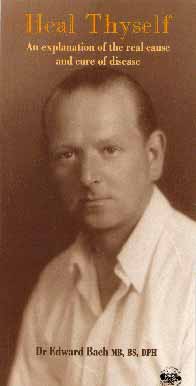
Almost all the information that we have about Dr Bach’s life comes either from the books, letters and pamphlets that he choose to leave behind, or from the biography of him written by Nora Weeks, who worked closely with him over many years.
In "The Medical Discoveries of Edward Bach Physician" Nora provides us with much fascinating information about his work but very little information about his private life. Bach himself carefully destroyed many of his letters and pamphlets before his death leaving only those that he wished others to see. We know from public records, that he married twice and had a daughter during his life but no mention of this is made in his biography, leaving us to fill in the gaps of the private face of Dr Bach for ourselves.
We can trace the path of Dr Bach’s life in distinct sections
- Childhood and early working life
- Medical studies and early years of medical practice.
- His work as an immunologist & the discovery of the 7 Nosodes.
- The last six years of his life and the discovery of the flower remedies.
The same driving force is evident throughout all of Dr Bach’s life, namely his absolute determination to find the truth about human illness & disease and to provide a cure in the form of a simple medicine available for all.
Childhood and early working life
Edward Bach was born on the 24th September 1886 in Moseley near Birmingham in the U.K. According to Nora Weeks the young Edward was a boy of determined nature, possessing great powers of concentration for those things that interested him. He had a great love of nature and overwhelming compassion for any who suffered. Even as a boy he dreamed of finding a simple form of medicine that would cure all forms of disease and also that healing power flowed from his hands - a dream which he realised during the course of his life.
On leaving school at the age of 16 the young Bach started his working life in the family brass foundry. Although he was determined to follow his dreams it seems that he found it difficult to ask his father for the necessary money and support that would be required for him to study medicine. During the three years that he worked in his father’s factories he studied the men that he worked with, noticing their difficulties and illnesses and how little real help the medical profession of his day could offer them. This increased his determination to study all known methods of cure, and he approached his father, who gladly offered the necessary support that would allow him to begin his studies at medical school.
Medical studies and early years of medical practice
At the age of 20 he entered Birmingham University, going on to University College Hospital in London to complete his studies. He qualified in 1912.
Even as a medical student Edward Bach spent little time with his books, since to him the true study of disease lay in observation of the patient and their differing reactions to their disease. He recognised that the same treatment did not always cure the same disease in all patients. He started to notice that those patients who shared similar personality characteristics often responded to similar treatment while others with different traits would need different treatment, although all were suffering from the same complaint. Practical experience and observation were the only true way of learning as far as he was concerned, and he had little use for accepted theories unless he could prove them for himself.
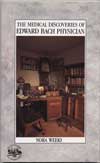
The Medical Discoveries of Edward Bach Physician
Nora Weeks worked with Dr Bach for many years, and this book gives a wonderful account of his life and his work, through the eyes of someone who knew him. A must for anyone wanting to find out more about Dr Bach and his life and work.
His work as an immunologist & the discovery of the 7 Nosodes.
In 1913 Bach became causality medical officer at University College Hospital and later in the same year casualty house surgeon at the National Temperance Hospital. However ill health forced him to give up the latter post and after a period of recovery he took a consulting room in Harley Street where he soon had a very busy practice. The busier he was the more dissatisfied he became with the results that he could achieve using orthodox medicine. He felt that at best he was only palliating and relieving symptoms and was even more convinced that the personalities of his patients should be given at least as much consideration as their symptoms.
Immunology & Bacteriology
He began to look around at other methods of healing and became interested in immunology, taking up the post of Assistant Bacteriologist at University College Hospital.
His pioneering work in this field eventually became famous throughout the medical profession. As a result of his research into intestinal bacteria he developed a series of nosodes or vaccines, which enabled him to help many with chronic disease who had previously been beyond help. These are now known as the Bach Nosodes. Again Bach was struck by the fact that the personality traits of those needing a particular nosode were usually similar and he eventually was able to prescribe the correct nosode for a patient based on personality alone.
Ill Health
He was an incredibly hard working man and the punishing schedule of patient responsibilities and research work that he set himself to accomplish began to take its toll of his health. Nora Weeks tells us that in 1917 he collapsed with a severe haemorrhage in the stomach and was operated on for cancer in his own hospital. The severity of the problem was such that he was given only three months to live. Desperate to continue with the work that he knew was not finished he pushed himself back to work as soon as he was able to walk and immersed himself in his experiments. At the end of three months he was surprised to discover that he was fully recovered.
1918 he left University College Hospital and set up his own laboratories to continue his research.
Introduction to Homoeopathy
In 1919 took up the position of pathologist and bacteriologist at the London Homoeopathic Hospital, where he discovered for the first time the work of Samuel Hahnemann ( more on Samuel Hahnemann ), founder of homoeopathy. As he read Hahnemann’s great work, the Organon, he was struck by the similarity of Hahnemann’s ideas to his own – treat the patient not the disease – was the message reiterated over and over again.
Incorporating Hahnemann’s ideas with his own Bach began to make his nosodes by the homoeopathic method of preparation, thus eliminating the need for a hypodermic syringe to administer the doses. Over the next several years Bach researched and refined his nosodes further, publishing his results in his pamphlets and books and the many public addresses that he gave. He became extremely well known in medical circles, gaining a high professional standing among orthodox and homoeopathic doctors, as well as running a busy Harley Street clinic.
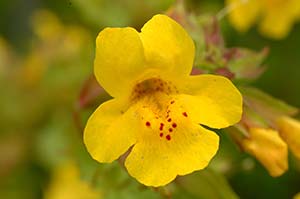
The beautiful Mimulus flower, one of the flowers that Dr. Bach used in his set of 38 Bach Remedies.
The Discovery of the Bach Flower Remedies
As successful as he was Bach knew that he had not yet found the simple form of medicine that he sort. Although the nosodes were very good they did not cure all cases and they were not made from the natural substances that he dreamed of.
He began actively searching for plants with the same patterning and signature that would take the place of the nosodes. However it was not until 1928 that the pieces of his puzzle began to fall into place. Diverting himself at a large dinner party by observing the other guests, he suddenly had the inspirational recognition that there were in fact more than the seven personality types that he had identified through his work with the nosodes. In that moment of inspiration he saw that as a group, all of humanity belonged to particular ‘type groups’.
From that moment on he redoubled his efforts to observe the way his patients reacted to their lives and circumstances, meticulously documenting all his findings and expanding his ‘type groups’.
The Beginning of the New Work
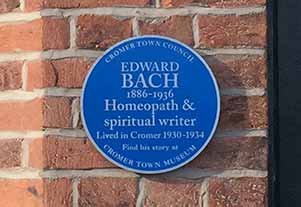
The blue plaque on the outside of Dr. Bach's house in Cromer, Norfolk. Dr Bach had a four year association with Cromer, from 1930 to 1934.
In September of 1928 he had a sudden intuition to go to Wales where he discovered his first two flowers; Impatiens and Mimulus, followed later in the same year by Clematis. He began using the remedies he prepared from these flowers on his patients and was so encouraged by the results that he decided to discontinue any other forms of treatment and to continue his search for other flowers to extend his work.
Early in 1930 he closed down all his work in London and left for Wales to search for the other flowers and plants that he needed to complete his work. Thus began the last phase of his life and one that could not have been easy to follow. He was at the time a very respected and eminent man in his field. Very few of his colleagues could follow his reasoning for the apparently sudden change of direction that he was about to take and many tried to make him change his mind. However to no avail, as he was absolutely convinced of his way forward. The result as we now know was his eventual discovery of 38 different remedies, together with the two unique methods of preparation that he developed for them.
Wales & Heal Thyself
Discovering How To Make The Flower Remedies
It was in Abersoch, in Wales, that Dr. Bach perfected the sun method of potentisation. In essence, what he discovered was that the power of the sun could transfer the energy or healing properties of a flower into water. He first discovered this when he experienced the healing effect of dew drops that he found on flowers that had sat in the power of the early morning sun. He found that he could replicate this effect by placing pure water in a thin glass bowl and floating the flowers on the surface of the water and leaving it outside in full morning sunshine for three hours.
Heal Thyself - Dr. Bach's Seminal Work on his Understandings of the Real Causes of Illness and Disease
Also while in Abersoch he wrote the manuscript for his book Heal Thyself - his seminal work on his understandings of the real causes of illness and disease. Nora Weeks wrote of Heal Thyself that "the book contains the fruits of the great knowledge of human nature he had gained during his many years of intense study of every type of individual in good and ill health, and explains the true cause of disease and the principles of the new healing". In his book, Dr. Bach lays out the philosophy behind the remedies, which is as simple as it is profound; that life on the physical plane of existence is intended to be a conscious partnership between the physical (personality) and non-physical (soul) aspects of ourselves. When we are in alignment with ourselves at all levels of our being, we come into balance at all levels, and essentially, this is what the wonderful 38 remedies help us to do.
The Importance of Cromer to Dr. Bach
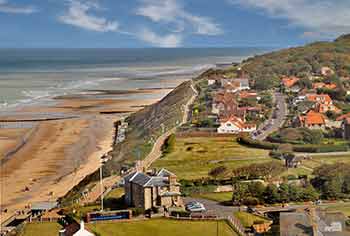
The seaside town of Cromer on the north Norfolk coast was a special place for Edward Bach
In 1930 Dr Bach started his four year association with the seaside town of Cromer, in Norfolk. He had a deep affection for the town and it's people and over the next four years he returned to Cromer to spend several months there each year.
He spent much time studying human nature there, finding a rich diversity of people from all walks of life. As well as studying, he also treated patients and discovered many of the 38 remedies in and around Cromer, including; Agrimony, Centaury, Cerato Chicory, Oak, Scleranthus and Vervain.
He also met Victor Bullen in Cromer, who would later help Nora Weeks to take forward the legacy of Dr Bach's work after his death.
Nora Weeks said that the months spent in Cromer had been ones of great happiness and satisfaction for Dr. Bach and that much of his research work had been done there along with the working out of the principles of the his new system of remedies.
The Rescue Remedy
It was also in Cromer that he may possibly have first used the combination of remedies that would later become known as Rescue Remedy ( what we call Revival Remedy ) to save the life of a sailor rescued pulled ashore during a terrific storm.
The Work Continues
Over the next few years Dr. Bach threw himself into the development of the remedies and the understandings that went with them. His characteristically determined and enthusiastic manner lead him to push himself to the limits, physically and emotionally in pursuit of his dream. And the journey he had set out on was not be an easy one either as his discoveries were decidedly revolutionary for the times and acceptance of them was not always easy to come by.
However, he was nothing if not determined, as Nora Weeks describes: "Edward Bach was fearless in all things, especially when any limitations or restrictions were likely to be enforced in connection with his work. When he was convinced of the value of a discovery that would be of benefit to the sick, he would let nothing stand in his way; no loss of personal status, no discouragement, no disbelief on the part of others could stop his employing all the means in his power to make the discovery known".
Early 1932 saw Dr. Bach temporarily back in London see patients and where he wrote Free Yourself, mainly in Regents Park, a place away from the hustle and bustle of London life. But by this time Dr Bach’s body, senses and intuition had became so sensitive that he found London life too much and lacking in the essential connection to nature that he and the work needed.
In Autumn 1933 Dr Bach published "The Twelve Healers and Four Helpers", a book about the flower remedies that he had discovered so far. This would later becomes the "The Twelve Healers and Other Remedies".
Sotwell and Mount Vernon
In March 1934 Edward Bach left Cromer and went in search of a cottage in a quiet village, and eventually found a house called Mount Vernon in the village of Sotwell near Wallingford. This is where the Bach Centre is now housed and you can go and visit his house and see where he lived and worked towards the end of of life. He settled there and decided to make this the headquarters of his work, making much of the furniture himself and working extensively in the gardens. He still travelled widely in search of his remedies and made more discoveries during the course of the year and completed the first nineteen of what would become the 38 Bach Remedies.
The New Nineteen Remedies and the Boiling Method
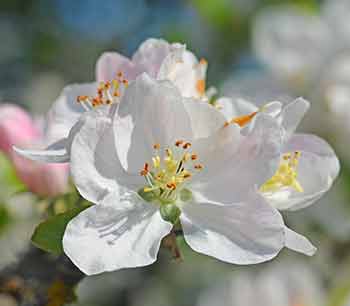
Crab Apple was one of the remedies in the second batch of nineteen remedies discovered and is a boiling method remedy... Crab Apple
1935 started with more discoveries and a new boiling method of preparation for all but one of these new nineteen remedies. They were also discovered in a different way too, with Dr. Bach feeling the states intensely before discovering the remedy to help. Nora Weeks described the process in the following way: "For some days before the discovery of each one he suffered himself from the state of mind for which that particular remedy was required, and suffered it to such an intensified degree that those with him marvelled that it was possible for a human being to suffer so and retain his sanity". This was the process that he went through for each of the nineteen new remedies and it must have taken a serious toll on his body.
The Twelve Healers and Other Remedies
Following discovery of the final of the 38 remedies, which Dr Bach regarded as a complete system, he published the "The Twelve Healers and Other Remedies", in Autumn 1936. This was his final and completed work on the Bach Flower Remedies. It's a beautifully simple book which gives a description of each of the 38 remedies and how to use them.
He then dedicated his time to seeing patients, writing about his new system, and training his team of helpers with great care in the use of the remedies.
Failing Health
However, while he had an incredible energy and drive to take his work out into the world, his body was beginning to suffer badly and it was struggling to keep up with the pace that he set and the energy that he put into everything he did. By October 1936 his health had deteriorated badly and he was confined to bed, which typically did not stop him from working and dealing with huge amounts of correspondence.
His focus now was on ensuring that the work could go on and be taken out further into the world by those who knew and loved the remedies. He also knew that he still had much work to do but was unsure whether it would be on the earth plane or another plane of existence.
Death - Passing From One Realm To Another
Dr Bach's love of life and sheer energy raised hopes that he might yet recover, but after one last rally, he passed peacefully in his sleep on the evening of the 27th November 1936, his mission at this level complete. Nora Weeks said that; "Life, to him, was continuous: an unbroken stream, uninterrupted by what we call death, which merely heralded a change of conditions; and he was convinced that some work could only be done under earthly conditions, whilst spiritual conditions were necessary for certain other work".
Edward Bach was 50 when he died, officially of cancer, although this mixed with overwork may have been closer to the mark. From his first diagnosis of cancer in 1917, when he had been given just three months to live, he had in fact lived for another 19 very full years. After his passing he was buried in St James' churchyard in Sotwell, just down the road from Mount Vernon.
Dr. Bach's Legacy
Although he lived a relatively short life, Edward Bach left a long and lasting legacy. His 38 Bach Flower Remedies have not only helped countless people all around the world since his passing, but have also lead to a whole field of new Flower & Vibrational Essences that have been created since. The beautiful and simple spiritual philosophy expressed in his writings have also been part of the spiritual unfoldment that is happening all around us. See also: Celebrating Dr Bach’s Life and Legacy.
Want to Find Out More?
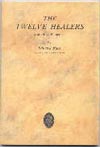
The following books are all interesting and inspiring:
- The Medical Discoveries of Edward Bach Physician - Nora Weeks' biography of Edward Bach.
- Heal Thyself - by Dr Bach - his seminal work on his understandings of the real causes of illness and disease.
- The Twelve Healers and Other Remedies - by Dr Bach - his definitive writing on his 38 flower remedies.
- The Collected Writings of Edward Bach - edited by Julian Barnard - a collection of all of Dr. Bach’s books and other writings.
Websites:
Are You New To The Bach Remedies?
You can find out more about The Bach Flower Remedies in our guide here.
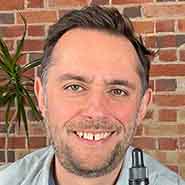
Sam Cremnitz
Sam is co-owner at Crystal Herbs and has been working professionally with Flower & Vibrational Essences since 1996. He is passionate about the Bach Flower Remedies and the work and understandings of Dr Edward Bach and the potential that they have to help people with their personal and spiritual growth. Sam is a trained essence practitioner, energy healer and teacher and loves sharing knowledge and information about essences and any other tools that help us to re-connect with our hearts and the true essence of who we are. More on Sam Cremnitz

